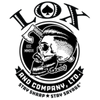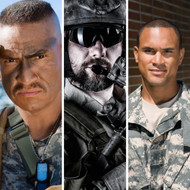High and Tight
Posted by Jason Keyser on May 1st 2020
It is a well-known fact that military personnel around the world have always adhered to certain dress and appearance rules. These rules range from the different uniforms that are allowed to hairstyle and facial hair. These are set through regulations that vary from country to country and likewise, differ between the military branches as well.
For example, the US Air Force regulation states that men must have haircuts:
“Tapered appearance on both sides and the back of the head, both with and without headgear. A tapered appearance is one that when viewed from any angle outlines the member’s hair so that it conforms to the shape of the head, curving inward to the natural termination point without eccentric directional flow, twists or spiking.” (Air Force Instruction 36-2903, 2014).
British armed forces come under similar regulation, with much of the final say being left to the commanding officer. The Royal Air Force regulations states:
“The hair of the head is to be well cut and trimmed. Sideburns are to be short and well-trimmed and are not to extend below a line running through the midpoint of the ear. Extreme styles of haircuts and coloring are not permitted. If the hair is dyed or highlighted, the color chosen is to be natural and in a uniform shade appropriate to the individual. The commanding officer shall be the arbiter upon what is or not an acceptable style or length of cut.” (Royal Air Force, AP 1358, 5th Edition).
There is some wiggle room in the rules for some individuality though. The soldier’s haircut is often the only form of self-expression they get within their unit. US Army regulation states:
“The requirement for hair grooming standards is necessary to maintain uniformity within a military population. Many hairstyles are acceptable, as long as they are neat and conservative.” (US Army dress regulations, AR 670-1.)
We will look at military hair styles and trends through out history. Starting with the Revolutionary War through today's modern soldiers. We will look at how the different styles of the time adapted to the regulations and some of the more common styles of today.
Continental Army (late 1700’s- early 1800’s)
During the time of the Revolutionary War the style of the time for men was long hair. The hair was usually powdered and tied. They would use a mixture of flour and tallow, a hard animal fat, to style the hair and would be tied into a “queue” or “pigtail”. If they were bald or balding, men of the time would often wear wigs to fake the appearance of long hair. Another reason for a longer hair styles during this time period was that there just weren’t that many barbers available in the American colonies at the time. Even so there were still regulations on hairstyle. Orders published by many commanders required male soldiers to wear their hair short or plaited (braided) up. Cavalrymen of the time preferred a “clubbed” hairstyle in which they gathered the hair at the back of the neck and tied it in a firm bundle, then folded it to the side before tying the final “club”. This was popular among mounted troops as they felt it stay in place during action of a mounted fight.
Beards were forbidden in the early days of the republic army. Soldiers were required to shave a minimum of three days a week, at least while in garrison. The rules were more lax if in an active campaign.
One major rule changed for military hair regulations in 1801. Maj. Gen. James Wilkinson, commanding general of the Army, abolished the “queue”. Most historians believe he took this action because the “pigtail” was a symbol of the British aristocracy and had no place in new US democratic republic. Wilkinson’s decision was met with a tidal wave of backlash. One soldier in particular, Lt. Col. Thomas Butler Jr. was even court-martialed because of his refusal to obey the no “queue” regulation.
Mid 1800’s – Civil War
The time leading up to the civil war hairstyle standards had changed distinctly, along with facial hair regulations. No facial hair was allowed on any soldier, except for mustaches on cavalry regiments. But, by the time the civil war started those regulations had been disregarded. Senior officers in both the Army and Navy wore beards and mustaches. While a beard could be worn “at the pleasure of the individual”, both branches preferred that is be kept short and tidily trimmed. This preference was, however, left up to much interpretation of the individual. Gen. Ulysses S. Grant kept a somewhat trimmed beard while Adm. Stephen B Luce had a much rougher look. The facial hair trend officially gave way to the clean shave look by the start of World War I.
Early 1900’s – WWI
World War I saw the abolishment of the beards and long hair for two main reasons. One, beards would not permit a proper seal on gas masks, and long hair was a breeding ground for lice and other parasites. Beards were outlawed and one inch was the maximum length for hair.
Mid 1900’s – WWII
During World War II, Army regulation was for all soldiers to “keep your haircut short and fingernails clean,” and most all branches of service had a medium-short tapered hair style. While beards were still against regulation, soldiers in sustained combat operations sometimes did grow beards – usually for no other reason than it was difficult to shave while under fire.
Beyond WWII – Modern Times
Following WWII, regulations on hair became fairly vague. The current, AR 670-1, states: Hair is to be well groomed and present a neat and orderly appearance. This leaves quite a bit open for interpretation and usually represents the individuality of the soldier.
Military Haircuts and Styles
The following paragraphs will be a guide of sorts to the different allowable hairstyles in the military. When you would see them and how they are cut.
Induction Cut
AKA: “Mighty fine”, “on the floor”, or “Army’s No.1 haircut”. A clipper cut with a 0 guard, leaving short stubble on the head. A new recruit receives his first haircut at the Cadet Barbershop during R-Day in processing at bootcamp. The induction cut serves both a practical and psychological purpose. First, it reduces the possibility of things like head lice. Secondly, it evens the playing field, making all new recruits equal and encourages a team mentality.
Once someone has passed basic training and has therefore, earned the right, a military man can decide what military haircut to wear full time.
Burr (AKA: Buzz) Cut
This buzz cut is one up from the induction cut, in terms of hair length. It is a uniform clipper cut with a 1 or 2 guard over the head, creating a uniform short and easy-to-care for hairstyle.
Butch Cut
A butch cut is a slightly longer buzz cut than the burr cut. It is created by clipper cutting the hair to a uniform length all over the head, using a 3-5 guard size. The hair at the ears and neckline can be faded out for a more tapered look.
Crew Cut
A short hairstyle that is tapered from the top of the head to the front hairline, creating more length at the front. It is also tapered down at the sides and back. Very popular haircut during World War II for military men and was regarded as athletic and patriotic. The crew cut continues to be popular today.
Fade Buzz Cut
A fade haircut, the sides and nape are clippered very short, even cut without a guard. It then fades upwards towards the top of the head, where the hair is cut more uniform with a little length.
Flat Top
This haircut forms a flat surface on the top of the head when the hair is brushed up. In addition, the sides and back of the hair are done with a short taper.
High & Tight
The high and tight is another type of fade haircut. It consists of very short back and sides, with a distinct patch of longer hair right on the top of the head. The sides are clippered above the temples (hence the “high” element of the name) using a guard number 1 or even no guard at all. It is this closeness of the cut to which the “tight” refers to. The sides could also be shaved. The hair on top goes straight round the crown and to the front hairline in a horseshoe shape. This patch of hair is clippered to one even length, using a guard size from 2 to 5.
The high and tight started in the 1960s and took off in the 1980s. It is particularly popular with US Marines, once they have earned the right to wear their hair like this, of course.
Ivy League - the Short Back & Sides
This is the haircut we always think of as the classic short back and sides.It is known in the USA as an Ivy League, named for its popularity among Ivy League undergraduates of the 1950s who favored this neat and tidy hairstyle. It is a graduated haircut that is largely scissor-cut, where the top hair is left longer and can be styled. The back and sides are tapered to a shorter length, which is finished with a fade.
It has been a popular style with military men for many decades. Nowadays, the Ivy League may be seen more on higher-ranking officials.
Regulation Cut
“Regulation” is a generic term that simply refers to the short haircuts that adhere to the military regulations. It could include any standard haircut like the crew or butch cut, or any variation of them. However, “regulation cut” also means a specific type of short cut. Here, there is a clear definition between the longer hair on top and the sharply tapered back and sides. The sides and back are either clippered very close or shaved, so that the scalp is plainly visible. This area of scalp is known as a whitewall. Furthermore, it is the height of a whitewall that determines whether it is a “low regulation” (short whitewall), a “high regulation” (tall whitewall) or a “medium regulation” (in the middle). To finish the look, the hair is parted on the side, creating a clean and straight line from front to back.
The regulation cut was a popular haircut with soldiers in the World War I, especially as heavy helmets were worn, often in freezing conditions.
Shaved Head
It is often worn in the United States military by those who have to motivate, for example drill instructors. A shaved head may also be preferred by someone who is bald or balding. Some armed forces do not permit shaved heads in general, stating that the haircut must be no shorter than a certain clipper guard grade.
Undercut or Bowl
This haircut was popular with German soldiers during the late 1930s and into the 1940s. The top of the hair is left quite long, while the back and sides are either shaved or clippered really close. There is little or no blending between the two lengths.
The Final Cut…
Just as styles and trends in hairstyles change every year, so to do the regulations for military personnel. Given the history of both the military and of hair trends, the future is certain to bring even more changes.
Team Lox would like to thank Jason from Male Forge for this excellent expose into the history and definitions of Military Hair Styles! Please check out his site, as well as his review of our products - if you liked this article, feel free to use the code: maleforge10 to save 10% on your next Lox order!
Stay Sharp. Stay Savage.

